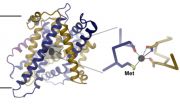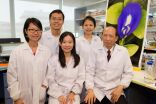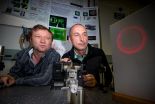Structure of an iron-transport protein revealed
2014-10-20
(Press-News.org) Iron is the most abundant trace element in humans. As a cofactor of certain proteins, it plays an essential role in oxygen transport and metabolism. Due to the major importance of iron in a wide variety of cellular processes, and the harm caused by its uncontrolled accumulation in the body, its uptake and storage is strictly regulated. In mammals, iron is imported into cells by the membrane transport protein DMT1. Mutations of DMT1, which affect its transport properties, lead to iron-related metabolic disorders such as anemia and the iron storage disease hemochromatosis.
Ines Ehrnstorfer, a PhD student in the group of Professor Raimund Dutzler at the Department of Biochemistry of the University of Zurich, and her colleagues, have determined the first structure of an iron transport protein. Their work was published in the scientific journal Nature Structural and Molecular Biology. Based on these results the researchers were able to explain why DMT1 binds the divalent metal ions iron and manganese (Fe2+ and Mn2+), but not calcium (Ca2+) – in spite of the latter being several orders of magnitude more abundant.
Moleclar basis for selective ion transport
To unravel the structural basis for this ion selectivity, Ines Ehrnstorfer has determined the structure of a close bacterial homologue of DMT1 by X-ray crystallography. The transport protein contains an ion binding site located at the center of the membrane that is composed of conserved amino acids. "One of these amino acids, a methionine, only interacts with transition-metal ions, but not with Ca2+", explains Ehrnstorfer. The study also shows that mutations in the binding site weaken ion binding and transport in both the bacterial homologue and human DMT1.
"The results thus reveal how transition-metal ions such as iron are selectively transported across the membrane, and they provide a basis for the development of specific inhibitors of DMT1 for the treatment of iron storage diseases," says the researcher. The project was funded by the Swiss National Science Foundation through the National Center of Competence in Research (NCCR) TransCure.
INFORMATION:
Literature:
Ines A Ehrnstorfer, et al. Crystal structure of a SLC11 (NRAMP) transporter reveals the basis for transition-metal ion transport. Nature Structural and Molecular Biology, advanced online publication October 19 2014. Doi: 10.1038/nsmb.2904
[Attachments] See images for this press release:

ELSE PRESS RELEASES FROM THIS DATE:
2014-10-20
How did life originate? And can scientists create life? These questions not only occupy the minds of scientists interested in the origin of life, but also researchers working with technology of the future. If we can create artificial living systems, we may not only understand the origin of life - we can also revolutionize the future of technology.
Protocells are the simplest, most primitive living systems, you can think of. The oldest ancestor of life on Earth was a protocell, and when we see, what it eventually managed to evolve into, we understand why science is so fascinated ...
2014-10-20
The drug combination umeclidinium/vilanterol (trade name Anoro) has been approved since May 2014 for adults with chronic obstructive pulmonary disease (COPD). In an early benefit assessment pursuant to the Act on the Reform of the Market for Medicinal Products (AMNOG), the German Institute for Quality and Efficiency in Health Care (IQWiG) examined whether this drug combination offers an added benefit over the appropriate comparator therapy.
According to the findings, an added benefit is not proven: For patients with moderate COPD severity and patients with fewer than ...
2014-10-20
Scientists at Nanyang Technological University (NTU Singapore) have discovered a new molecule which can join together chains of amino acids – the building blocks of protein.
Only three other known molecules have been discovered to be able to perform this function, which is an important process in the development of new drugs. A key difference is that the new molecule is able to do the same process 10,000 times faster than the other three and "cleanly" without leaving any residue behind.
This new molecule, which is a type of catalyst or enzyme, was derived from ...
2014-10-20
Researchers at VTT Technical Research Centre of Finland, the University of Turku and the University of Oslo have discovered a previously unknown molecular-level mechanism that may partly explain the increased growth of cancer cells. The study, published in the British Journal of Cancer, showed that high levels of miRNA-378a-5p molecule cause cell division anomalies. This renders the number of chromosomes in cancer cells abnormal, which is known to promote growth and the spread of cancer. In addition, the researchers discovered that elevated miRNA378a-5p levels in breast ...
2014-10-20
Laser physicists have built a tractor beam that can repel and attract objects, using a hollow laser beam that is bright around the edges and dark in its centre.
It is the first long-distance optical tractor beam and moved particles one fifth of a millimetre in diameter a distance of up to 20 centimetres, around 100 times further than previous experiments.
"Demonstration of a large scale laser beam like this is a kind of holy grail for laser physicists," said Professor Wieslaw Krolikowski, from the Research School of Physics and Engineering at The Australian National ...
2014-10-20
What does a 1980s experimental aircraft have to do with state-of-the art quantum technology? Lots, as shown by new research from the Quantum Control Laboratory at the University of Sydney, and published in Nature Physics today.
Over several years a team of scientists has taken inspiration from aerospace research and development programs to make unusually shaped experimental aircraft fly.
"It always amazed me that the X-29, an American airplane that was designed like a dart being thrown backwards, was able to fly. Achieving this, in 1984, came through major advances ...
2014-10-20
A pilot study testing a new type of drug in patients with chronic diarrhoea has shown promising effects on reducing their symptoms.
Bile acid diarrhoea (BAD) is a common cause of chronic diarrhoea that is estimated to affect one in 100 adults in western countries, but is often mistaken for irritable bowel syndrome (IBS) by doctors. Many patients are not diagnosed correctly and undergo repeated unnecessary tests.
The study at Imperial College London found that the drug obeticholic acid (OCA) could provide relief for patients with BAD. OCA is the first in a new class ...
2014-10-20
Researchers at NYU Langone Medical Center conclude new drug in development may offer first alternative to standard chemotherapy for T-Cell Acute Lymphoblastic Leukemia.
Researchers at NYU Langone Medical Center and elsewhere say that blocking the action of an enzyme "switch" needed to activate tumor growth is emerging as a practical strategy for treating T-cell acute lymphoblastic leukemia.
An estimated quarter of the 500 U.S. adolescents and young adults diagnosed each year with this aggressive disease fail to respond to standard chemotherapy drugs that target cancer ...
2014-10-20
Washington, D.C.— Hydrogen—the most abundant element in the cosmos—responds to extremes of pressure and temperature differently. Under ambient conditions hydrogen is a gaseous two-atom molecule. As confinement pressure increases, the molecules adopt different states of matter—like when water ice melts to liquid and then heats to steam. Thus far, at extreme pressures hydrogen has four known solid phases. Now scientists, including Carnegie's Alexander Goncharov, have combined hydrogen with its heavier sibling deuterium—which has an added neutron ...
2014-10-20
This issue of Health Affairs was supported by CVS Health.
Do specialty drugs offer value that offsets their high costs?
James D. Chambers of Tufts Medical Center and coauthors conducted a cost-value review of specialty versus traditional drugs by analyzing incremental health gains associated with each. This first-of-its-kind analysis is timely because the majority of drugs now approved by the Food and Drug Administration are specialty drugs produced using advanced biotechnology and requiring special administration, monitoring, and handling—all of which result ...
LAST 30 PRESS RELEASES:
[Press-News.org] Structure of an iron-transport protein revealed



